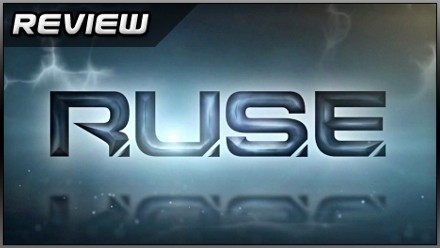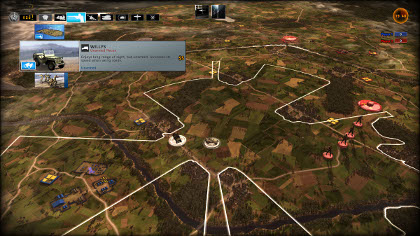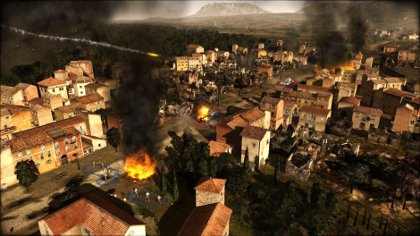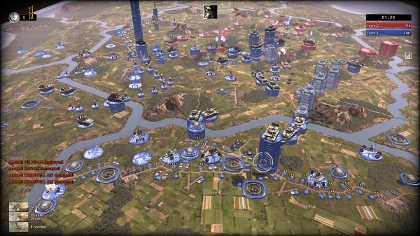
If you’ve read much about RUSE, chances are you’ve read about it in connection with something else. Helmed by Parisian small-timer Eugen Systems, the project attracted notoriety last year when the PC version was attached to Ubisoft’s proprietary ‘always online’ DRM software, thankfully absent from final code. On the console front, the game has often been perceived purely in terms of its PlayStation Move compatibility: updates to existing titles like Heavy Rain aside, it will be the one unequivocally ‘core-oriented’ release to support Sony’s svelte Wiimote-killer at launch.
The substance of RUSE has gotten somewhat lost in the politics, then. Rather appropriate, that, for a game so disposed to misdirection. Like fellow unsmiling acronym-peddler HAWX, this umpteenth virtual tour of World War II stakes its claim to your pennies on a gimmick, the application of region-based powers or ‘ruse cards’ to deceive rival generals, uncover their secrets or empower your units directly – but its ‘gimmickry’ is mere marketing camouflage, veiling a cleverly tucked-back and nicely balanced RTS.
The mode selection is pretty straightforward, encompassing a 10-15 hour campaign, six one-off battles or ‘Operations’ derived from famous scenarios like the Normandy landings, a 22 map skirmish mode with customisable bots and tech levels, and free-for-all or two-vs-two online multiplayer. I could have held out for a map editor myself, but what’s here cuts the mustard.
RTS solo escapades traditionally serve as fattened-up tutorials, wheeling out each pean or mechanic one trial-and-repetition-driven mission at a time, and RUSE sticks so closely to the formula it all but winds up with friction burns. Experienced or more easily bored tacticians may chafe at the hand-holding, which is accompanied by performance-killing pop-in video and info windows (to say nothing of the storyline, a tepid affair of tea-sipping Brits and glowering unshaven Yanks). Given the sheer specificity of each unit’s capabilities, however, the stateliness with which Eugen peels back the layers is welcome.
The rock on which RUSE is founded is the rock on which any decent top-down tank-trasher ought to be founded: unit balance. The developer has scored an unqualified win in this department, skimming the froth from the history books and boiling it down to the familiar archetypes of infantry, armour, anti-armour, recon, artillery, aerial and anti-aerial – skewed a bit according to faction (there are six – Italy, Russia, Britain, France, Germany and the US), with the odd ‘experimental weapon’ game-changer available at great expense.

This is a PC beta shot, I'm afraid - Xbox 360 ones are hard to come by. The white line shows a unit's field of view.
Squaring off these archetypes effectively – positioning artillery to flatten Panthers, for example, or sending Hurricanes to divebomb light tanks before they can run down your marines – soaks up the bulk of the brainpower investment, with only a handful of upgrades to research, a dozen or so buildings (constructed along roads) to worry about, and a resourcing aspect that takes care of itself once the relevant supply depots have been assimilated.
While staying on the right side of the terrain can be vital, with infantry able to casually annihilate whole armoured columns from the shelter of swamps, towns and woodlands, RUSE pulls up a few furlongs short of any Total-War-esque niceties of height, incline or cover – partly because this would detract from the macro game, and partly, I suspect, because the Xbox 360′s analog sticks are as imperfect a precision instrument here as elsewhere. An expanding ‘brush’ reticule, sliding production menus and group-select hotkeys ensure fluid control with practice, but picking out individual units – as when deploying individual riflemen squads around the fringes of a forest – remains awkward right up to the ending credits.
The interface’s real triumph comes hand-in-hand with Eugen’s technical achievement: reel in the right stick, and the camera will plummet away from the game’s alright-ish vehicle and terrain textures to a vertiginous overview, the fiction back-pedalling simultaneously from the crash and churned grit of combat to the cardboard discs and arrows of a tactician’s map room. It’s from this comfortable remove, with the disposition of the entire battlefield in your lap, that players will generally want to implement the 10 titular ruse cards.
Never quite compelling during the campaign, where the odds are scripted, ruses begin to show their worth in multiplayer and skirmish face-offs, where they occasion some quite brilliant out-manoeuvrings of raw material fact. Some are more obviously useful than others – Blitzkrieg is always a good opening gambit, doubling the speed of your construction trucks, and Radio Silence enables many a cheap victory till opponents get wise, as invisible paratroopers swarm bases from behind. But each card has its place, temporarily corrupting the game’s otherwise incorruptible tactical logic.
While there’s some truth to the idea that Eugen has simply put a bolder spin on the secondary or support abilities one might find in an older RTS, the freshness this endows is fantastic. Together with the stripped-back construction and resource schemes, and the digestible but flexible unit hierarchy, the notion of ruse cards moves proceedings closer to the mistrustful intimacy of a round of poker. Is that innocently advancing light unit a ranger, or a Tiger Tank masquerading as such? Has the other guy cottoned onto the fact that your forward airfield is only a balsa-wood replica? Truth is, indeed, the first casualty, but it certainly won’t be the last.
It’s doubtful RUSE will manage to con its way into Mainstream Land – we are, after all, talking about a World War II RTS – but this game is proof at least that ‘serious’ strategy simulation, often excitably proclaimed ‘dead’, has plenty to offer given a willingness to tear out dead wood, to turn monolithic inherited feature-sets on their heads and expose the asymmetries and outright underhandedness that gave titles like Advance Wars their charm.

Score guide hyah, readers. Bonus question: what was the most successful tank model of the Second World War?







 Satoru Iwata Video Interview - the late Nintendo president spoke with Kikizo in 2004 as 'Nintendo Revolution' loomed.
Satoru Iwata Video Interview - the late Nintendo president spoke with Kikizo in 2004 as 'Nintendo Revolution' loomed. Kaz Hirai Video Interview - the first of Kikizo's interviews with the man who went on to become global head of Sony.
Kaz Hirai Video Interview - the first of Kikizo's interviews with the man who went on to become global head of Sony. Ed Fries Video Interview - one of Xbox's founders discusses an epic journey from Excel to Xbox.
Ed Fries Video Interview - one of Xbox's founders discusses an epic journey from Excel to Xbox. Yu Suzuki, the Kikizo Interview - we spend time with one of gaming's most revered creators.
Yu Suzuki, the Kikizo Interview - we spend time with one of gaming's most revered creators. Tetris - The Making of an Icon: Alexey Pajitnov and Henk Rogers reveal the fascinating story behind Tetris
Tetris - The Making of an Icon: Alexey Pajitnov and Henk Rogers reveal the fascinating story behind Tetris Rare founders, Chris and Tim Stamper - their only interview? Genuinely 'rare' sit down with founders of the legendary studio.
Rare founders, Chris and Tim Stamper - their only interview? Genuinely 'rare' sit down with founders of the legendary studio. The History of First-Person Shooters - a retrospective, from Maze War to Modern Warfare
The History of First-Person Shooters - a retrospective, from Maze War to Modern Warfare
Panzer?
What about those big four-legged things from The Empire Strikes Back? Did they have them in WW2?
Edwin.For real?!Those things are supposed to be in the future!!!!!!!!!In WWII the machine gun was brand new!!DO YOU THINK THEY COULD MAKE LAZERS?!?!?!?!
It’s a tank.Ever read a book?
That depends on how you define successful.
The Tiger was one of the finest tanks of the war, but intricately engineered and prone to breakdowns.
The Sherman was terrifyingly inferior to the Tiger, but was so cheap and easy to produce that the Americans shipped them over in incredible numbers. It took ten Shermans to stop a Tiger, but the allies had 13.
The T-34 was revolutionary and rocked the Germans’ world. It was every bit as good as its German adversaries *and* it was produced in vast numbers.
So, I guess my vote goes to the T-34.